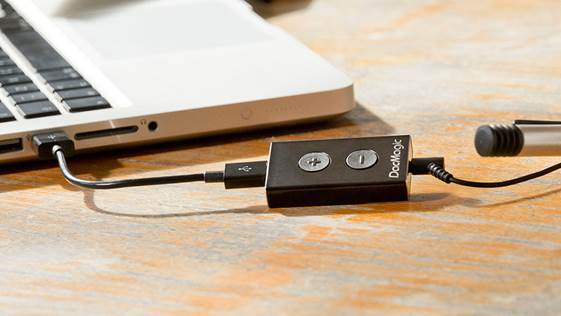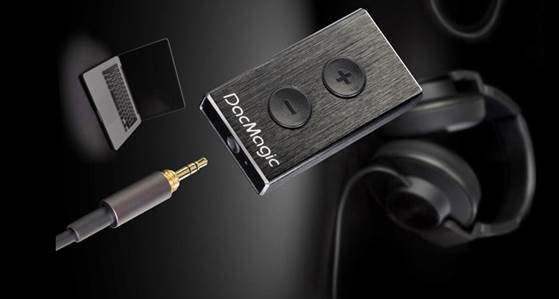Cambridge Audio already has a couple of very capable DACs on
its books in the shape of the DacMagic 100 and DacMagic Plus – but these are
both reasonably hefty desktop units that require mains power. The
ultra-portable DacMagic XS that completes the range is a dinky USB model.
And, although the DacMagic XS is one of the cheapest devices
in its class, there’s little to suggest this: the packaging is slick and the
product itself has a nice finish. It’s a little chunkier and wider than the
DragonFly and the Audio-engine, but build quality is impressive – it feels just
as substantial and looks the business too.

DacMagic XS
Connections are simple: there’s a micro-USB input on one end
for connecting to your computer (a supplied connector cable completes the
chain) and a standard 3.5mm socket for your headphones on the other.
A single, hardworking LED shows the sample rate of the
incoming audio signal – blue for 44.1/48kHz, green for 88.2/96kHz and purple
for 176.4/192kHz – as well as the amp’s volume limits.
Really easy to use
Where the AudioQuest and Audio-engine DACs take their volume
cues from your computer, the XS has its own in the shape of circular ‘+’ and
‘-’ buttons on top of the device. If you press them both at once and hold for a
few seconds, they also switch the DAC operation from USB 1.0 to 2.0. The
advantage here is that the DacMagic XS will now accept a native high-resolution
24-bit/192kHz stream. In USB 1.0 mode it is limited to 24-bit/96kHz (PC users
will have to download additional drivers from Cambridge’s website to enable
this).
There’s a hidden benefit to the USB 2.0 mode, and that is
better sound quality generally. Even with a standard 16-bit/44.1kHz rip of Lady
Gaga’s Do What you Want, we preferred listening in USB 2.0 mode. The track
sounds more focused, stable and confident and there’s plenty of well-organized
detail for the listener to take note of.
The Cambridge gives the track good weight and momentum too,
with agile, precise and subtle lows spurring the tune along. The DacMagic’s
refined tonal balance is hugely comforting, and helps take the edge off
brittle- or bright-sounding recordings. If you’re used to using your laptop or
desktop computer’s headphone output for listening to music, the DacMagic is
likely to be a big step up.

DacMagic XS
The DacMagic’s refined tonal balance is hugely comforting,
and helps take the edge of bright-sounding recordings. It’s a big step up from
a computer’s headphone output.
Smooth, full-bodied sound
Make the switch to a higher-resolution track and the your
enjoyment goes up with the jump in bits. Kate Bush’s 50 Words For Snow
(24-bit/96kHz) sounds subtle and intricate. The XS delivers plenty of insight
and has a silky smooth, delicate way with vocals – there’s plenty of warmth
here and a nice, full-bodied balance. The story is similarly positive with a
recording of Beethoven’s Piano Concerto No.4 in G Minor.
We do think AudioQuest DragonFly sounds clearer, though, and
also has the edge in terms of outright resolution and dynamic subtlety.

DacMagic XS
The Cambridge Audio has no trouble dispatching the Fiio and
Audio-engine DACs. Its main problem is the fierce competition provided by the
AudioQuest DragonFly and its all-new price tag. That DAC is only $49.3 more and
is definitely worth spending the extra on for the notable jump in sound
quality.
|
Specifications
- Converter:
ESS9023 24-bit digital to analog converter
- Output voltage:
2V RMS
- Power:
150mW
- SNR: 103
dBr, un-weighted
- Crosstalk:
66dB
- Dimensions:
30 x 54 x 10 mm
- Weight: 3.5 oz (100g)
|